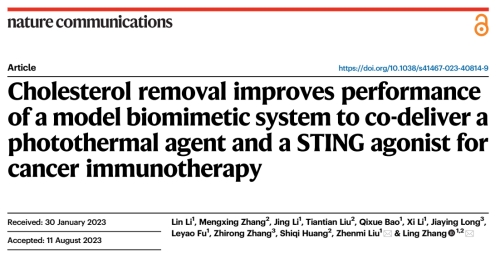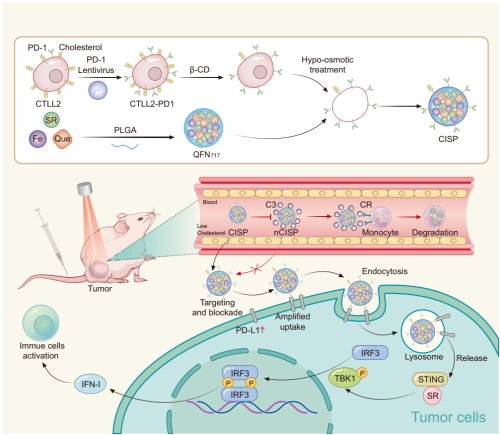The research team of Zhenmi Liu and the research team of Ling Zhang from theWest China School of Public Health(WCSPH) and West China Fourth Hospital, Sichuan University collaborated and recently published a research paper titled "Cholesterol Removal Improves Performance of a Model Biomimetic System to Co-deliver a Photothermal Agent and a STING Agonist for Cancer Immunotherapy" online in Nature Communications.The first author of the paper is Lin Li, a postdoctoral fellow in the Institute of System Epidemiology of the West China School of Public Health/West China Fourth Hospital. Zhenmi Liu and Ling Zhang are the co corresponding authors of the paper.

“As an important type of biomimetic drug delivery system, cell membrane-coated nanoparticles have been widely studied in recent years and displayed various advantages in targeted delivery of drugs. However, many of these works were conducted in nude mice which have a compromised immune system, and the efficiency of these delivery systems in immunocompetent mice remains to be improved. However, the sizes, morphology, and proteins of cell membranes used in delivery system are different from those of normal cells in the blood, and it is difficult for them to avoid being recognized as foreign objects and cleared by phagocytes. For example, in the blood flow, complement proteins could deposit on the surface of nanoparticles in a process called opsonization. These proteins then prime the particle for removal by immune cells like phagocytes in the blood, which could lead to diminished targeted accumulation and adverse effects. Hence, reducing the adsorption and activation of complements on the surface of cell membrane-coated nanoparticles may significantly improve their performance” (Introduction)

“Biological membranes often play important functional roles in biomimetic drug delivery systems. We discover that the circulation time and targeting capability of biological membrane coated nanovehicles can be significantly improved by reducing cholesterol level in the coating membrane. A proof-of-concept system using cholesterol-reduced and PD-1-overexpressed T cell membrane to deliver a photothermal agent and a STING agonist is thus fabricated. Comparing with normal membrane, this engineered membrane increases tumor accumulation by ~2-fold. In a melanoma model in male mice, tumors are eliminated with no recurrence in >80% mice after intravenous injection and laser irradiation; while in a colon cancer model in male mice, ~40% mice are cured without laser irradiation. Data suggest that the engineered membranes escape immune surveillance to avoid blood clearance while keeping functional surface molecules exposed. In summary, we develop a simple, effective, safe and widely-applicable biological membrane modification strategy. This "subtractive" strategy displays some advantages and is worth further development.” (Abstract)
The research work was funded by the National Natural Science Foundation of China's Outstanding Youth Science Fund project (82022070) and the Regional Innovation and Development Joint Fund (No: U20A20411).
https://pubmed.ncbi.nlm.nih.gov/37607938/
